You’ll discover that Long Island’s coastal plants have mastered survival in one of nature’s harshest environments. These resilient species endure constant salt spray, sandy soils, and fierce winds that would kill most garden varieties. From the vibrant yellow blooms of Seaside Goldenrod to the sweet-scented Beach Rose, these natives offer beauty without the typical maintenance headaches. Understanding which species work best in your specific microclimate, however, requires knowing something most gardeners overlook.
Contents
- 1 Long Island’s Maritime Climate Influence
- 2 Salt-Tolerant Blooming Perennials
- 3 Wind-Resistant Coastal Native Trees
- 4 Low-Maintenance Coastal Native Shrubs
- 5 Selecting the Right Native Plants for Your Garden
- 6 Frequently Asked Questions
- 6.1 When Is the Best Time to Plant Coastal Natives in Long Island?
- 6.2 How Much Do Coastal Native Plants Typically Cost Compared to Non-Natives?
- 6.3 Where Can I Purchase Coastal Native Plants on Long Island?
- 6.4 Do Coastal Native Plants Attract Deer or Other Wildlife Pests?
- 6.5 How Long Does It Take for Coastal Native Plants to Establish?
Long Island’s Maritime Climate Influence
Because Long Island sits between two major bodies of water, you’ll find it experiences a unique maritime climate that shapes everything from daily weather patterns to which plants thrive along its shores. The Atlantic Ocean and Long Island Sound create moderating effects that keep summer temperatures around 81°F and winter averages near 37°F.
This maritime climate directly influences coastal ecology by creating distinct microclimates. Areas south of Sunrise Highway stay notably cooler due to ocean breezes, while the sound’s east-west orientation differs from typical north-south coastal patterns. The island’s maximum width of 23 miles means that maritime influences reach across the entire landmass, affecting plant distribution patterns. These conditions determine which native plants can successfully establish themselves.
Salt-Tolerant Blooming Perennials
Salt-tolerant blooming perennials provide reliable color and ecological benefits in coastal Long Island gardens, encompassing core varieties, additional highlights, growth adaptations, planting considerations, and notable native candidates. These locally grown native plants are sourced from the Northeastern U.S. to ensure optimal adaptation to regional conditions.
Seaside Goldenrod (Solidago Sempervirens)

Seaside Goldenrod is a robust herbaceous perennial wildflower that stands 2-8 feet tall with thick, waxy succulent leaves and bright yellow flower clusters. This coastal native blooms from August through October, providing essential late-season nectar for bees and butterflies when few other plants are flowering. Its evergreen basal leaves form attractive clumps topped by arching branches of one-sided yellow flower heads.
Unlike other goldenrod species, Seaside Goldenrod doesn’t spread aggressively by rhizomes, making it an excellent choice for naturalized coastal gardens and dune restoration projects. Its exceptional salt tolerance and deer resistance make it ideal for challenging coastal environments where many plants struggle to survive. The plant thrives in diverse coastal habitats including dune slacks, maritime wet grasslands, and tidal marshes.
- Hardiness: USDA zones 3-9
- Light: Full sun
- Water: Drought tolerant once established; moderate water needs
- Soil: Sandy, well-draining soils; highly salt tolerant
- Fertilizer: Low fertility requirements; thrives in poor soils
- Pest/Disease Resistance: Deer resistant; generally pest and disease free
- Growth Rate: Moderate; forms clumps 18-30 inches wide
New England Aster (Symphyotrichum)
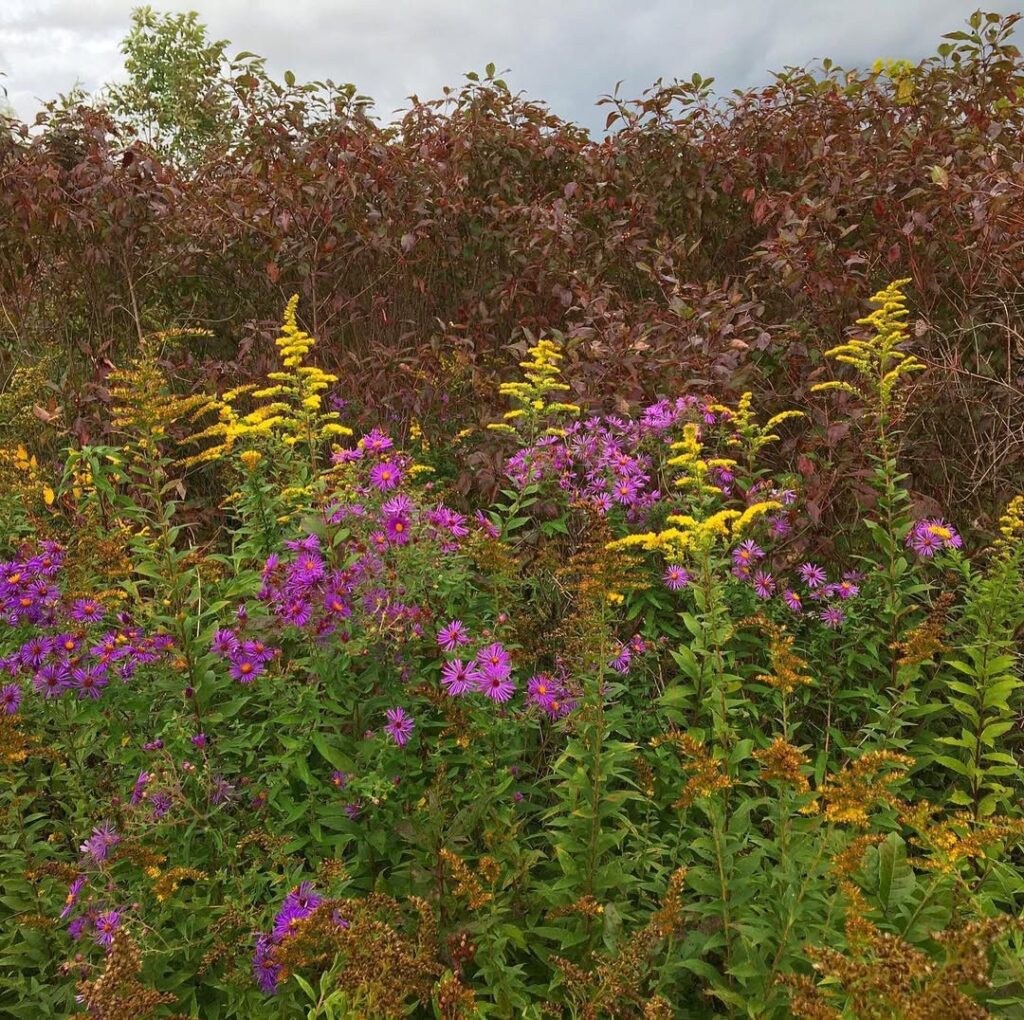
The New England Aster (Symphyotrichum novae-angliae) is an exceptional salt-tolerant perennial that brings vibrant late-season color to Long Island’s coastal landscapes. This sturdy native plant produces masses of daisy-like flowers in purple, pink, and deep lavender shades with bright orange-yellow centers from late summer through October.
Beyond its ornamental value, New England Aster serves as a vital wildlife magnet, attracting numerous pollinators including native bees, butterflies, and serving as an important nectar source for migrating Monarch butterflies. Its moderate salt tolerance and ability to withstand coastal conditions make it ideal for seaside gardens, while its dense foliage and strong stems handle salt spray and ocean breezes with ease. The plant is naturally deer-resistant, making it an excellent choice for areas where deer browsing is a concern.
- Hardiness: Zones 4-8, excellent cold tolerance for Long Island conditions
- Light: Full sun preferred; tolerates partial shade but flowering decreases
- Water: Consistent moisture preferred; avoid prolonged drought conditions
- Soil: Moist, well-drained, slightly acidic soils; adapts to average coastal soils
- Fertilizer: Low maintenance; thrives in rich soils but doesn’t require regular feeding
- Pest/Disease Resistance: Generally resistant; may experience powdery mildew in humid conditions
- Growth Rate: Moderate to fast; can become aggressive in ideal conditions
Beach Rose (Rosa Rugosa)
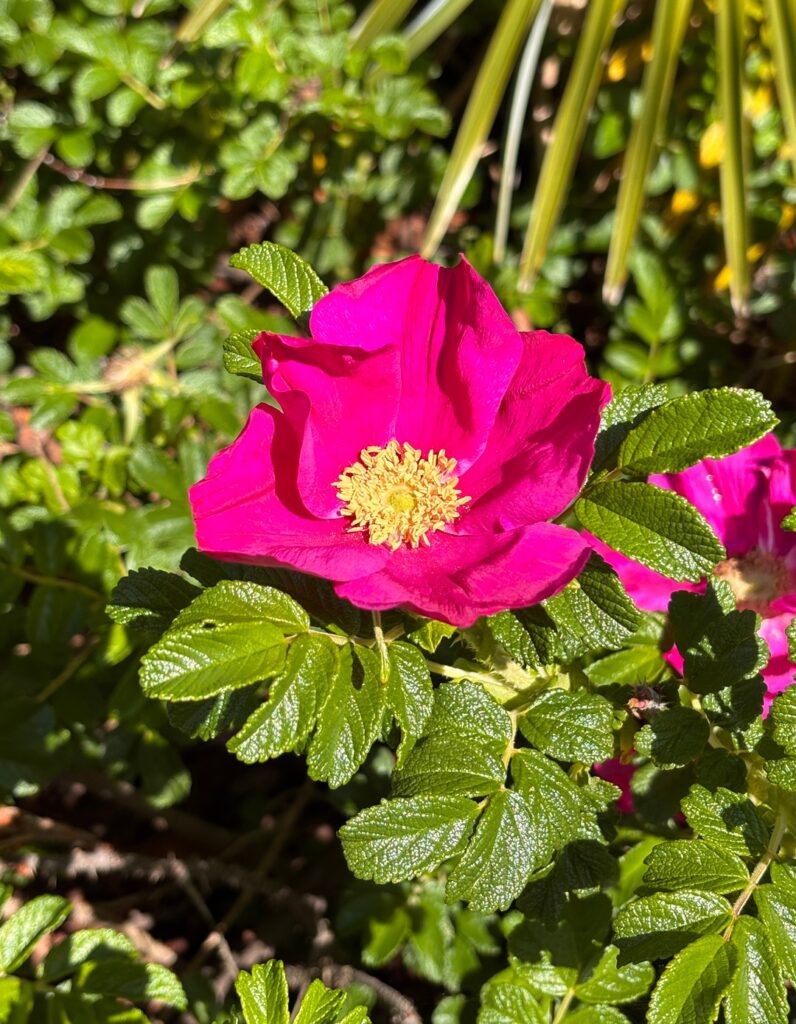
Beach Rose (Rosa rugosa) is a hardy, salt-tolerant shrub that forms dense thickets 3-6 feet tall along Long Island’s coastlines. Despite being commonly perceived as native, it was actually introduced from Asia in the 1770s. This robust perennial produces fragrant pink or white flowers from May through September, often blooming simultaneously with its large, edible rose hips in late summer.
The plant’s distinctive rugose (wrinkled) leaves and numerous straight prickles make it easily recognizable. Its ability to thrive in harsh coastal conditions, combined with its extended blooming period and attractive fruit, makes it popular for seaside landscaping, though it can become invasive in some areas. The species is well-adapted to conserve water in dry coastal dune habitats where many other plants struggle to survive.
- Hardiness: Very hardy, tolerates harsh coastal conditions and winter storms
- Light: Full sun to partial shade
- Water: Drought tolerant once established, minimal watering needed
- Soil: Adaptable to sandy, gravelly, or stony soils; thrives in poor, well-draining coastal soils
- Fertilizer: Low maintenance, rarely requires fertilization
- Pest/Disease Resistance: Excellent resistance to most pests and diseases
- Growth Rate: Moderate to fast, spreads readily through suckering
Sea Lavender (Limonium)
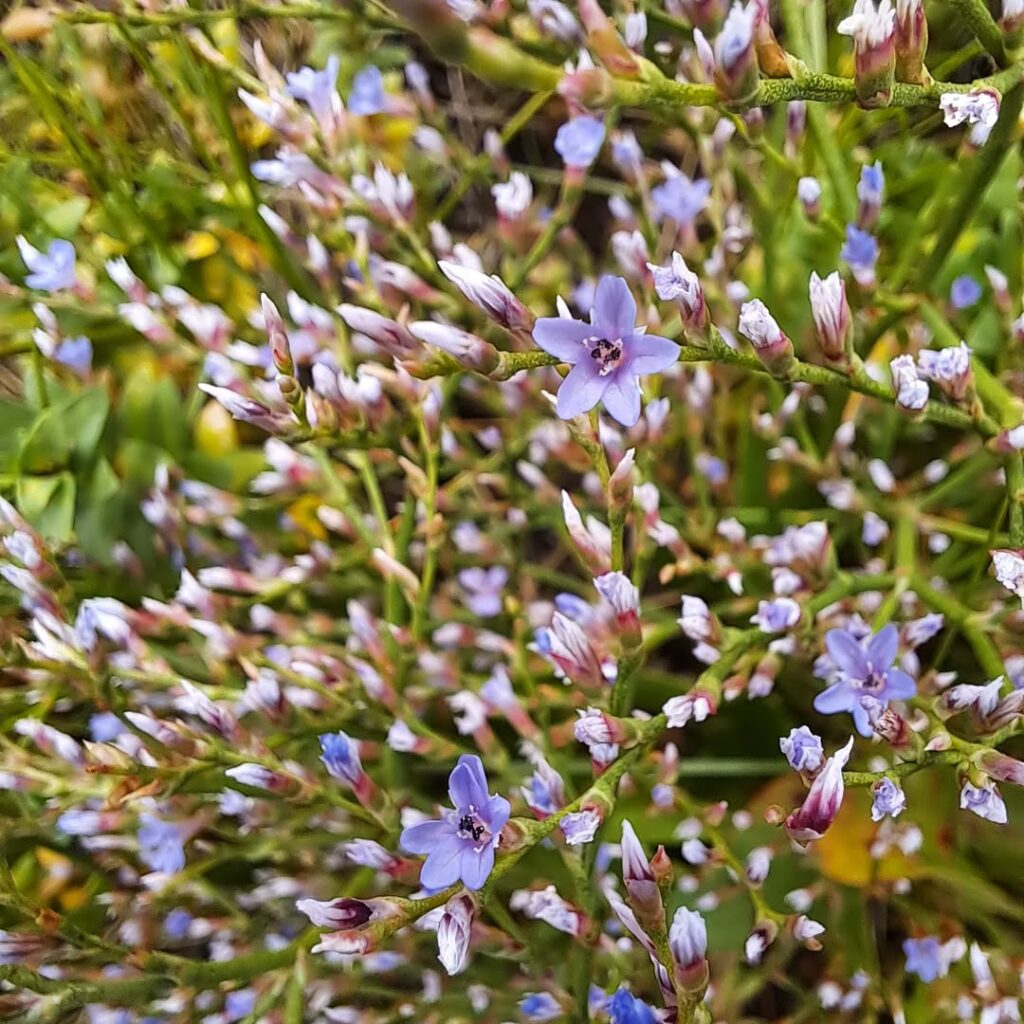
Sea lavender (Limonium) is a salt-tolerant coastal perennial that produces masses of tiny lavender-blue flowers on wire-like stems from July through August. This hardy plant features distinctive red-tinted stems and leathery, spoon-shaped basal leaves that create striking contrast with its airy flower structure. The delicate blooms are complemented by white bracts that often outlast the flowers themselves.
Thriving in harsh coastal conditions, sea lavender forms attractive clumps and readily self-seeds when left undisturbed. Its exceptional salt tolerance and wind resistance make it invaluable for seaside gardens and exposed sites. The plant provides excellent habitat for pollinators while offering high deer resistance and winter interest as dried flowers remain attached to stems. These beautiful blooms are also excellent for cutting both fresh and for dried flower arrangements.
- Hardiness: Perennial suited for coastal environments and barrier islands
- Light: Full sun with tolerance for coastal exposure
- Water: Prefers dry soil conditions once established
- Soil: Adapts to loam, organic, sandy, and clay soils; slightly acidic to slightly alkaline pH
- Fertilizer: Low maintenance requirements; no specific fertilization needed
- Pest/Disease Resistance: High resistance with occasional black aphid issues; no significant disease problems
- Growth Rate: Moderate; forms colonies through self-seeding
Wild Bergamot (Monarda Fistulosa)

Wild Bergamot (Monarda fistulosa) is a versatile native perennial that brings both beauty and ecological value to Long Island coastal gardens. Growing 2-4 feet tall with fragrant, tubular flowers in shades of lavender, purple, pink, or white, this aromatic herb blooms in midsummer with distinctive wispy flower clusters. Its square stems and mint-scented foliage make it a standout choice for pollinator gardens, naturalized areas, and herb gardens.
This adaptable native thrives in Long Island’s climate while providing essential habitat for hummingbirds, butterflies, and beneficial insects. Though it can spread vigorously through seeds and rhizomes, regular maintenance keeps it manageable. Wild Bergamot’s moderate salt tolerance and drought resistance make it particularly valuable for coastal plantings, while its historical medicinal and culinary uses add cultural significance to any garden setting. The aromatic leaves can be used to make mint tea, providing an additional benefit for gardeners interested in herbal beverages.
- Hardiness: USDA Zones 4-8
- Light: Full sun to partial shade
- Water: Medium-moist to dry; drought tolerant once established
- Soil: Well-drained sand, loam, or clay; tolerates poor, rocky, or sandy soils; adaptable to acidic, neutral, or alkaline pH
- Fertilizer: Low maintenance; thrives in poor soils without supplemental feeding
- Pest/Disease Resistance: Generally resistant to major pests and diseases; good heat tolerance
- Growth Rate: Moderate to fast; can spread vigorously through rhizomes and self-seeding
Wind-Resistant Coastal Native Trees
Long Island’s coastal native trees possess specialized adaptations for surviving harsh winds, featuring deep root systems, flexible branches, and dense canopies that provide natural storm resistance. These resilient species like pines and cedars have proven their ability to withstand the extreme conditions found along barrier beaches, including salt exposure and winter storms.
Eastern Red Cedar (Juniperus)

Eastern Red Cedar (Juniperus virginiana) is an exceptionally hardy native evergreen that thrives in Long Island’s coastal conditions. Despite its common name, this species is actually a juniper rather than a true cedar. Growing 30-65 feet tall with a distinctive pyramidal or columnar crown, it features reddish-brown peeling bark and blue-green to dark green foliage that shifts from needle-like to scale-like with age.
This resilient tree is perfectly adapted to coastal environments, tolerating salt spray, strong winds, and sandy soils. Female trees produce distinctive blue berry-like cones while males bear small brown cones. Eastern Red Cedar provides valuable wildlife habitat and food sources, particularly for Cedar Waxwing songbirds. Its deep taproot system and exceptional environmental adaptability make it an excellent choice for windbreaks and erosion control in coastal landscapes. With proper care, these remarkable trees can live for over 850 years, making them a truly long-term investment in your landscape.
- Hardiness: USDA zones 2-9, extremely cold and heat tolerant
- Light: Full sun to partial shade
- Water: Drought tolerant once established, adaptable to wet or dry conditions
- Soil: Tolerates wide range including poor, rocky, alkaline, and sandy soils
- Fertilizer: Low maintenance, no fertilizer required
- Pest/Disease Resistance: Generally resistant, but serves as alternate host for cedar-apple rust
- Growth Rate: Moderate to slow, depending on conditions
American Holly (Ilex Opaca)
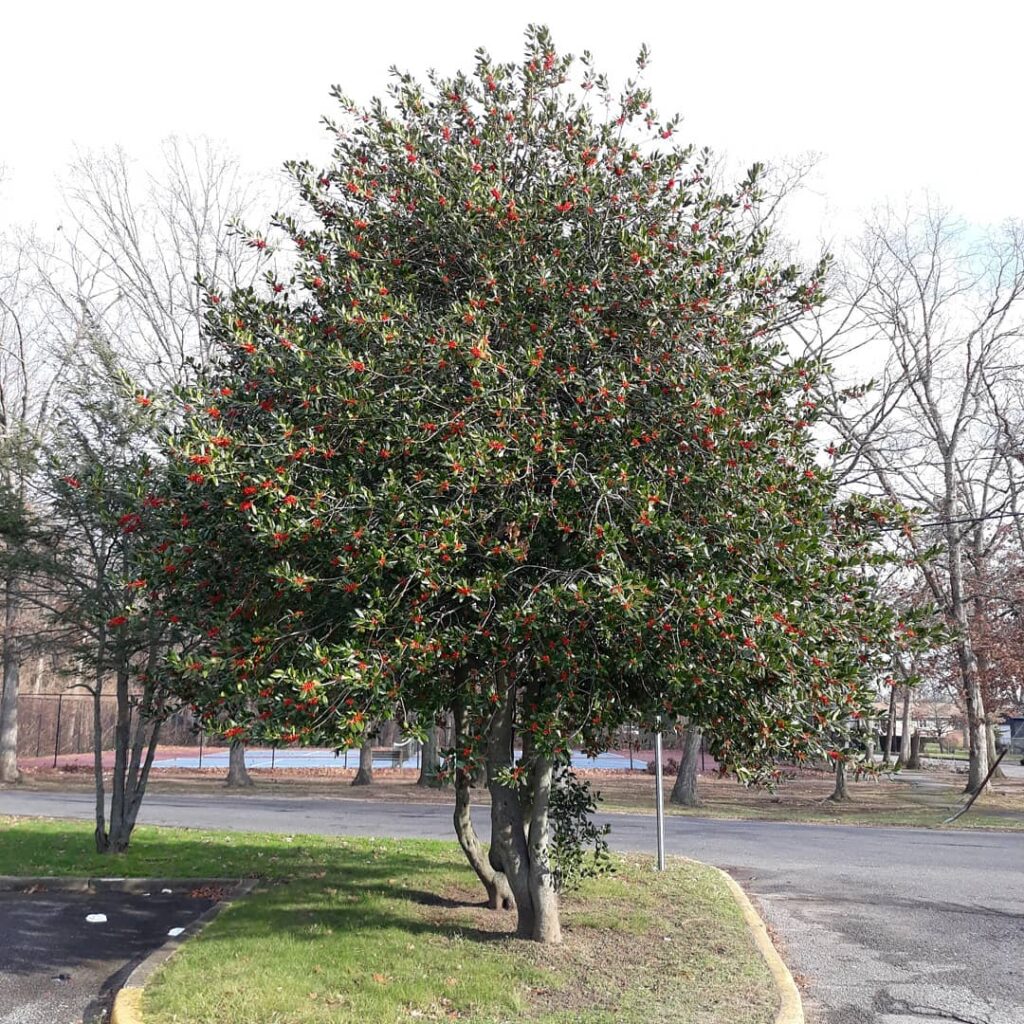
American Holly (Ilex opaca) is an evergreen tree native to the eastern United States that makes an excellent wind-resistant choice for Long Island’s coastal areas. This hardy tree features distinctive leathery leaves with sharp points and produces bright red berries in late fall, making it valuable for both ornamental purposes and holiday decorations.
The species demonstrates remarkable coastal adaptation with its tolerance to salt spray and moderate drought conditions once established. Its thick canopy provides excellent windbreak protection while supporting local wildlife, as the berries feed numerous songbird species and the flowers attract pollinators including bees and moths. The wood is pale and tough, making it historically valuable for cabinet work and whip-handles. American Holly serves effectively as a specimen tree, hedge, or screen planting in coastal landscapes.
- Hardiness: USDA zones 5B-9, suitable for Long Island climate
- Light: Full sun to partial shade, thrives best in sunny environments
- Water: Moderate moisture requirements, drought tolerant once established
- Soil: Moist, well-draining, neutral to acidic soils (pH 3.5-6), intolerant of limestone
- Fertilizer: Low maintenance, no special fertilizer requirements
- Pest/Disease Resistance: Highly deer resistant, prone to root rot in overly wet conditions
- Growth Rate: Slow growing but long-lived
Pitch Pine (Pinus Rigida)
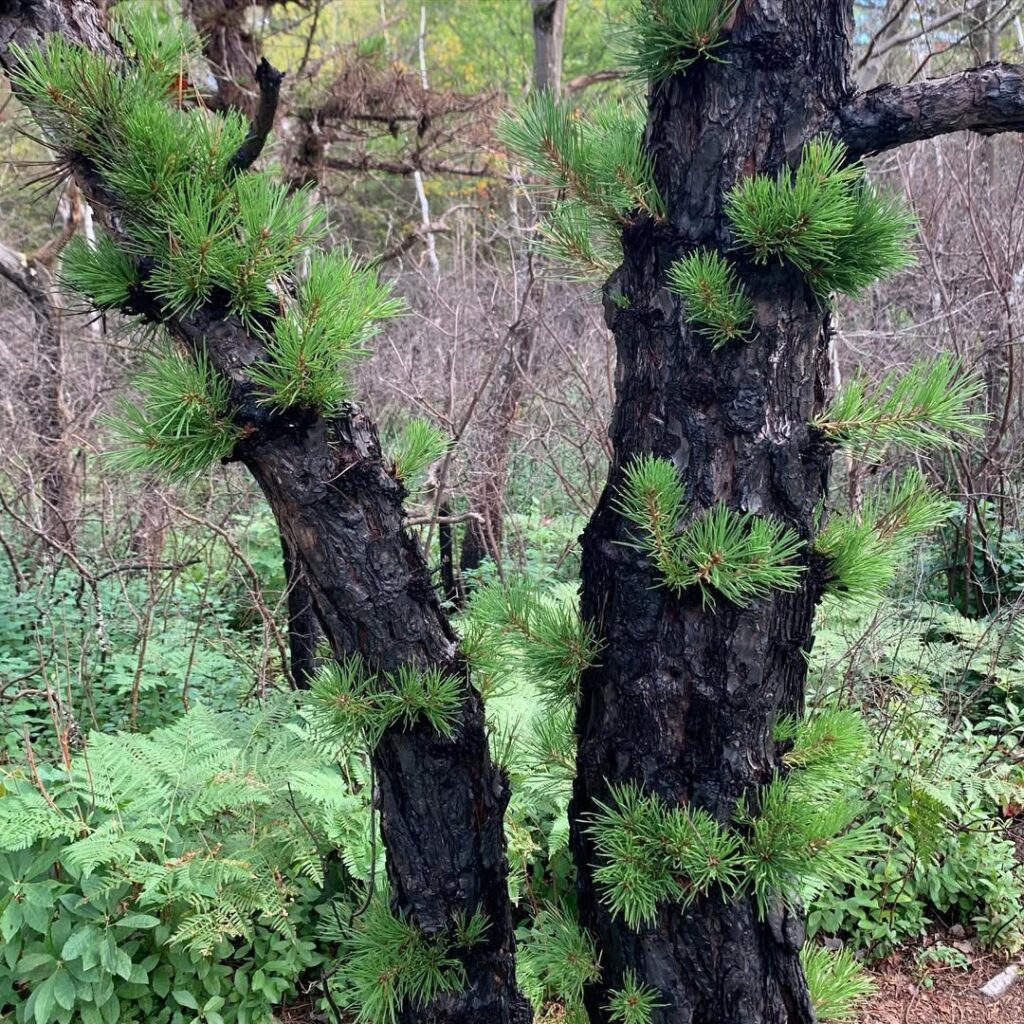
Pitch Pine (Pinus rigida) is a hardy coastal native tree perfectly adapted to Long Island’s challenging sandy environments. As the primary species of the Atlantic coastal pine barrens, it thrives in the globally rare dwarf pine plains community. This pioneer species colonizes cleared sites and tolerates extreme conditions that defeat other trees, including acidic soils, salt spray, and drought.
With its characteristically stiff, sharp needles and irregular growth habit in exposed locations, Pitch Pine serves as both a windbreak and wildlife habitat. Its high resin content and remarkable resilience make it an excellent choice for coastal landscaping where other trees struggle to survive. The tree demonstrates exceptional regenerative ability, capable of re-sprouting after trunk damage from storms or fire.
- Hardiness: USDA Zone 4, tolerates temperatures as low as 14°F (-10°C)
- Light: Full sun, thrives in exposed situations
- Water: Drought tolerant once established, prefers 45-50 inches annual rainfall
- Soil: Sandy, acidic, low-nutrient soils; excellent for poor, rocky conditions
- Fertilizer: None required, adapted to nutrient-poor environments
- Pest/Disease Resistance: High resistance due to resin content and hardy nature
- Growth Rate: Moderate, pioneer species that establishes quickly on disturbed sites
Black Cherry (Prunus Serotina)

Black Cherry (Prunus serotina) is a majestic native tree reaching 70-90 feet tall, distinguished by its finely toothed leaves and striking ornamental features. In spring, it produces showy clusters of white flowers, followed by small black fruits that attract wildlife. The tree displays vibrant yellow fall foliage and attractive dark bark, making it an outstanding landscape specimen.
This fast-growing pioneer species thrives in open forests and forest edges throughout eastern North America, including Long Island. While adapted to various conditions, Black Cherry requires full sun and well-drained soils to reach its best potential. Its ecological value is significant, serving as a host plant for butterflies and providing food for birds and mammals, though it may inhibit nearby garden plants through allelopathic compounds. As a keystone species, Black Cherry supports an extensive network of wildlife, with research showing it can support hundreds of caterpillar species that serve as crucial food sources for birds and other animals.
- Hardiness: Cold and heat tolerant, suitable for Long Island’s coastal climate extremes
- Light: Full sun to partial shade; highly averse to deep shade
- Water: Consistent soil moisture preferred; not highly drought-tolerant
- Soil: Well-drained sandy or loamy soils; prefers acidic conditions below pH 6.8
- Fertilizer: Minimal requirements as a native pioneer species
- Pest/Disease Resistance: Susceptible to Eastern tent caterpillars; requires monitoring
- Growth Rate: Fast-growing in suitable habitats and favorable conditions
Sassafras (Sassafras Albidum)

Sassafras (Sassafras albidum) is a versatile medium-sized deciduous tree native to eastern North America, including Long Island’s coastal regions. This pioneer species typically reaches 30-59 feet in height and often develops multiple trunks, making it suitable for naturalizing in coastal forests and disturbed areas. Known for its distinctive mitten-shaped leaves and fragrant foliage, sassafras provides excellent wildlife habitat while demonstrating remarkable adaptability to Long Island’s variable coastal conditions.
The species excels as a wind-resistant coastal native, thriving in the well-drained sandy soils characteristic of Long Island’s glacial outwash plains. Its deep taproot system and drought tolerance make it particularly valuable for coastal restoration projects, though its tendency to spread by root suckers requires management for single-trunk specimens. The tree produces yellow-green flowers in early spring before the leaves emerge, adding seasonal interest to coastal landscapes.
- Hardiness: USDA zones corresponding to eastern North America climate, tolerates coastal wind exposure
- Light: Full sun to partial shade, adaptable to various light conditions
- Water: Drought tolerant once established, prefers well-drained conditions, intolerant of wet soils
- Soil: Well-drained sandy acidic soils preferred, pH 6.0-7.0 ideal, tolerates nutrient-poor conditions
- Fertilizer: Minimal requirements, adapted to nutrient-poor sandy soils
- Pest/Disease Resistance: Generally resistant, benefits from coastal environment conditions
- Growth Rate: Medium growth rate, pioneer species establishing quickly in disturbed areas
Low-Maintenance Coastal Native Shrubs
Long Island’s coastal environments demand resilient native shrubs that withstand salt spray, sandy soils, and harsh conditions while requiring minimal care once established. These hardy plants support conservation and biodiversity efforts by providing habitat for local wildlife while maintaining the natural character of coastal landscapes.
Bayberry (Myrica Pensylvanica)
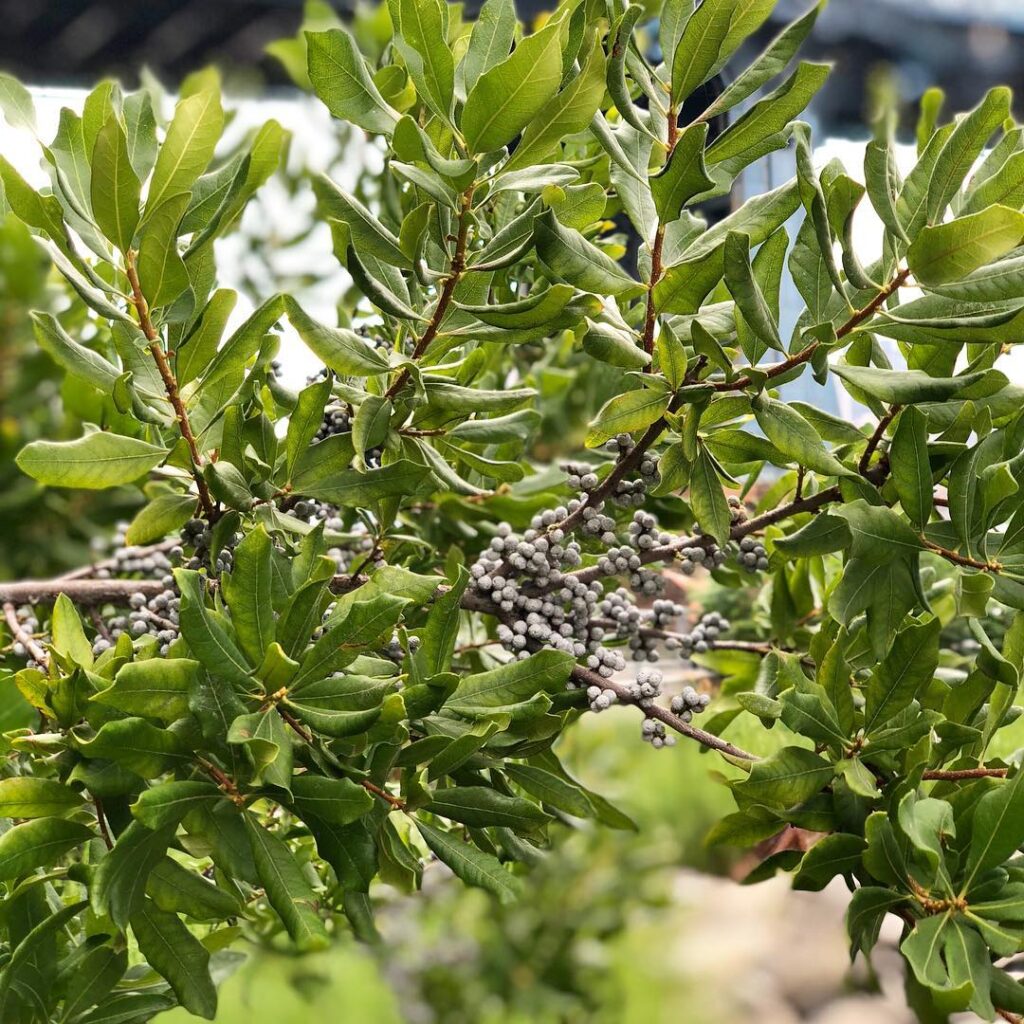
Bayberry is a highly adaptable, spreading shrub that reaches 3-12 feet in height and 5-8 feet in width. This semi-evergreen native features glossy, fragrant gray-green leaves and produces attractive blue berries on female plants. Native from Newfoundland to North Carolina, it’s exceptionally well-suited for coastal environments where it naturally colonizes sandy dunes.
One of the Northeast’s most durable native shrubs, bayberry excels in tough growing conditions where other plants struggle. Its remarkable salt spray tolerance and wind resistance make it invaluable for coastal landscapes, while its low-maintenance nature and deer resistance add to its appeal. The plant provides excellent ecological value as habitat for wildlife and helps with erosion control through its rhizomatous spreading growth. The persistent white berries on female plants provide winter interest and serve as an important food source for birds during the colder months.
- Hardiness: USDA zones 3-7, native to Mid-Atlantic coastal regions
- Light: Full sun to partial shade
- Water: Drought tolerant once established, moderate water needs
- Soil: Sandy, peaty, or slightly acidic well-drained soils preferred
- Fertilizer: Low fertility requirements, thrives in poor soils
- Pest/Disease Resistance: Excellent, mostly pest and disease-free
- Growth Rate: Moderate, spreads naturally via rhizomes
Beach Plum (Prunus Maritima)
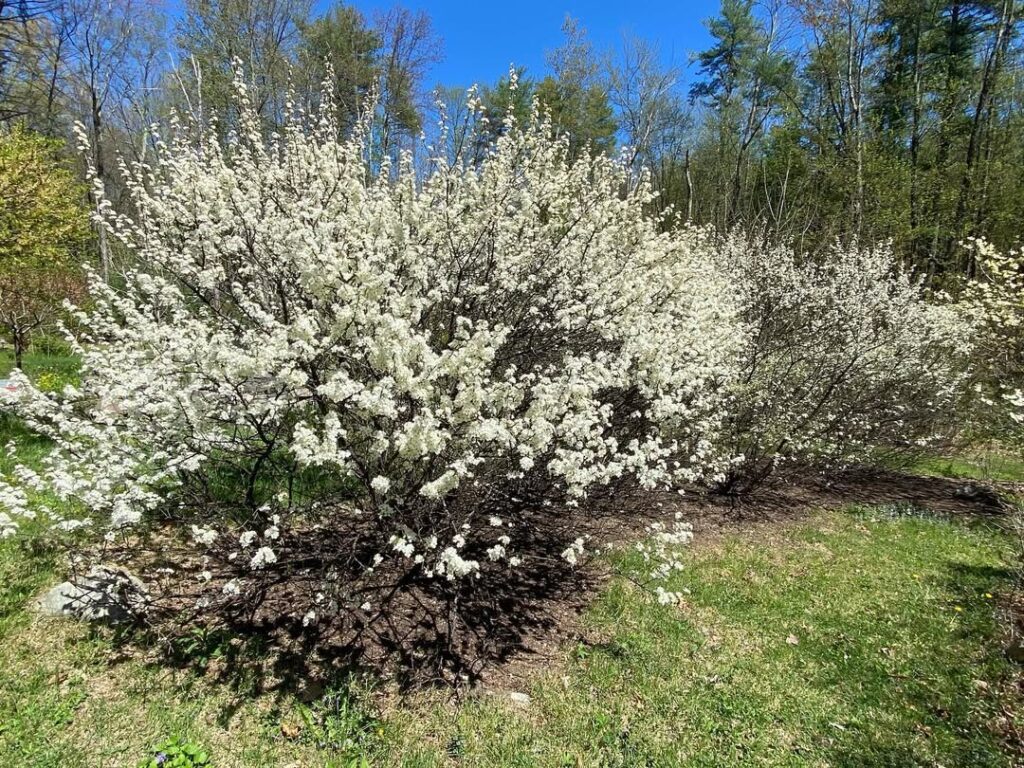
Beach Plum (Prunus maritima) is a native deciduous shrub perfectly adapted to Long Island’s coastal environments. Growing 3-6 feet tall with a dense, rounded form, this hardy plant thrives in sandy soils and salt-laden conditions where other shrubs struggle. Its suckering habit creates natural thickets that provide excellent erosion control along dunes and shorelines.
Beyond its practical benefits, Beach Plum offers seasonal beauty with clusters of white spring flowers, vibrant fall foliage in shades of red and orange, and edible purple-black fruits perfect for jams and jellies. As a host plant for over 400 butterfly and moth species, it serves as a cornerstone of coastal ecosystems while requiring minimal maintenance once established. The glossy leaves provide an attractive dark-green backdrop throughout the growing season, maintaining their lustrous appearance even in harsh coastal winds.
- Hardiness: Cold hardy and highly salt tolerant, suitable for Long Island’s coastal zones
- Light: Full sun preferred for ideal flowering and fruiting
- Water: Drought tolerant once established; prefers moderate moisture but adapts to dry conditions
- Soil: Well-drained, sandy soils; thrives in poor, coastal soils
- Fertilizer: No fertilizer needed; adapted to nutrient-poor coastal conditions
- Pest/Disease Resistance: Excellent resistance with few pest or disease problems
- Growth Rate: Moderate growth rate; spreads naturally through suckers to form colonies
Inkberry (Ilex Glabra)
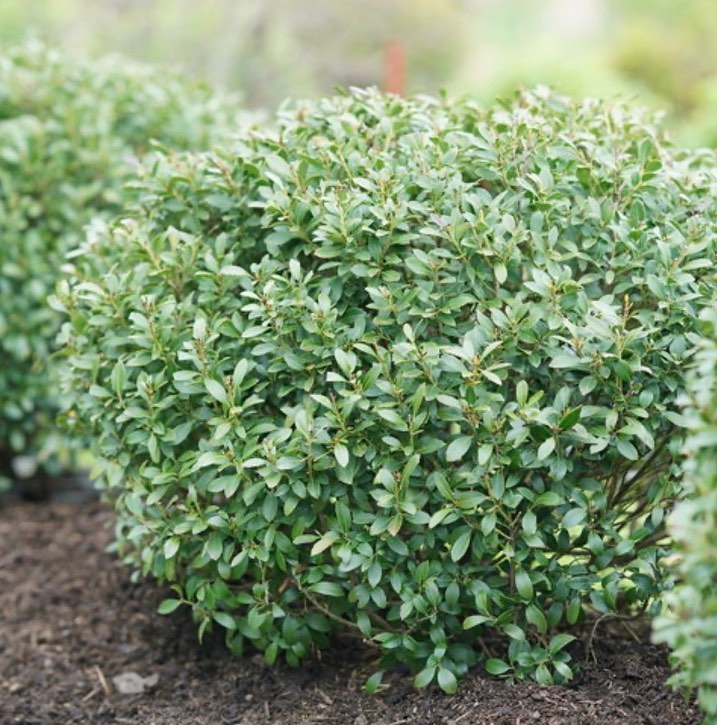
Inkberry (Ilex glabra) is a versatile evergreen shrub native to Long Island’s coastal regions, growing 2-12 feet tall with dark green, glossy foliage that provides year-round interest. This low-maintenance native serves as an excellent alternative to boxwood for hedging and mass plantings, producing black berries that feed wildlife from fall through winter. Its ability to sucker and form dense thickets makes it valuable for naturalizing and erosion control in coastal landscapes. The availability of multiple size options, ranging from 1 quart to 10 gallon containers, makes it suitable for both residential and commercial landscaping projects of varying scales.
- Hardiness: USDA Zones 5-10
- Light: Full sun to moderate shade
- Water: Wet to dry conditions; highly adaptable to varying soil moisture
- Soil: Rich, well-drained, acidic soils (pH 3.5-6.0); tolerates sandy or clay soils
- Fertilizer: Low requirements; thrives without regular fertilization
- Pest/Disease Resistance: Moderately deer resistant; tolerates salt spray
- Growth Rate: Moderate; suckers readily to form spreading colonies
Arrowwood Viburnum (Viburnum Dentatum)
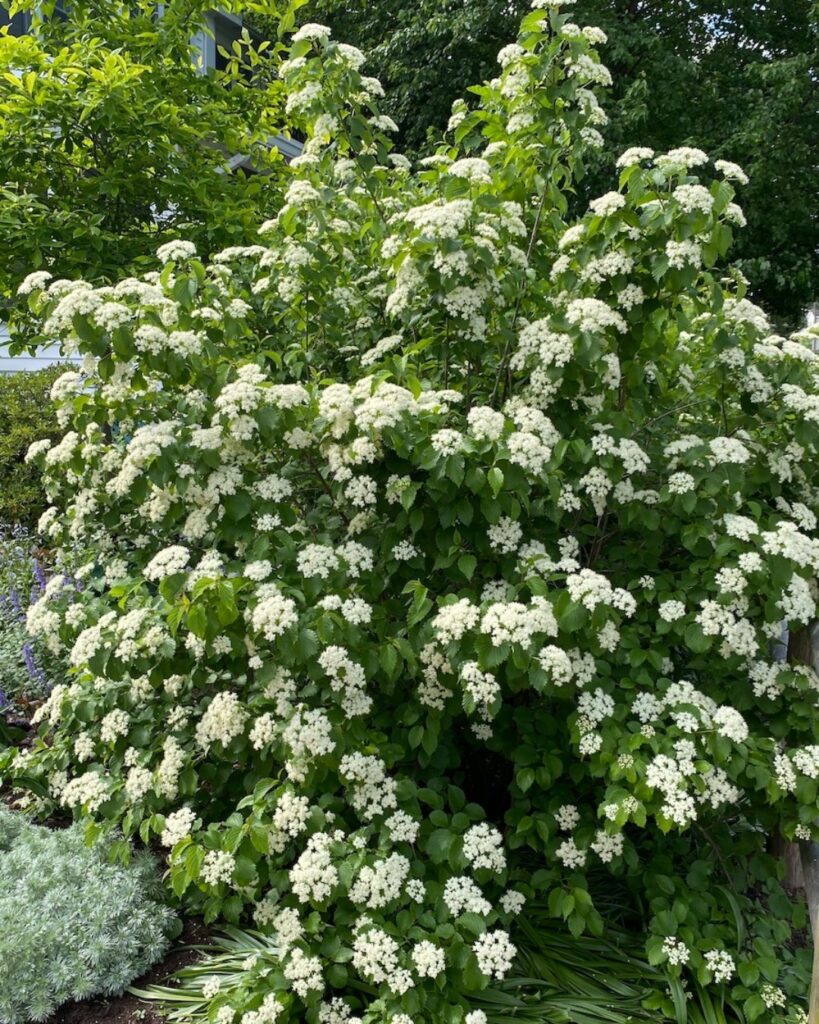
Arrowwood Viburnum is a versatile native shrub that excels in Long Island’s coastal conditions. This low-maintenance plant produces clusters of white flowers in late spring followed by dark blue berries that provide essential late-season wildlife food. Growing 10-15 feet tall and wide, it forms attractive dense thickets through natural suckering.
Particularly valuable for coastal gardens, Arrowwood Viburnum demonstrates exceptional adaptability to various environmental conditions while supporting local wildlife. Its flowers attract butterflies and native bees, while the berries feed numerous bird species and small mammals. The shrub offers year-round interest with spring blooms, summer berries, and reddish-purple fall foliage. The plant serves as a larval host for Spring Azure butterflies, making it especially valuable for supporting native pollinator populations.
- Hardiness: Zones 2-8, highly adaptable to coastal conditions
- Light: Full sun to full shade, very versatile light requirements
- Water: Drought tolerant once established, flood tolerant, prefers consistently moist soil
- Soil: Adaptable to sandy, loamy, clay, rocky soils; prefers acidic to neutral pH (5.1-6.8)
- Fertilizer: Low requirements, benefits from organic mulch
- Pest/Disease Resistance: Generally strong resistance, occasional aphids or viburnum beetle
- Growth Rate: Moderate, begins fruiting at 3-4 years
Elderberry (Sambucus Canadensis)
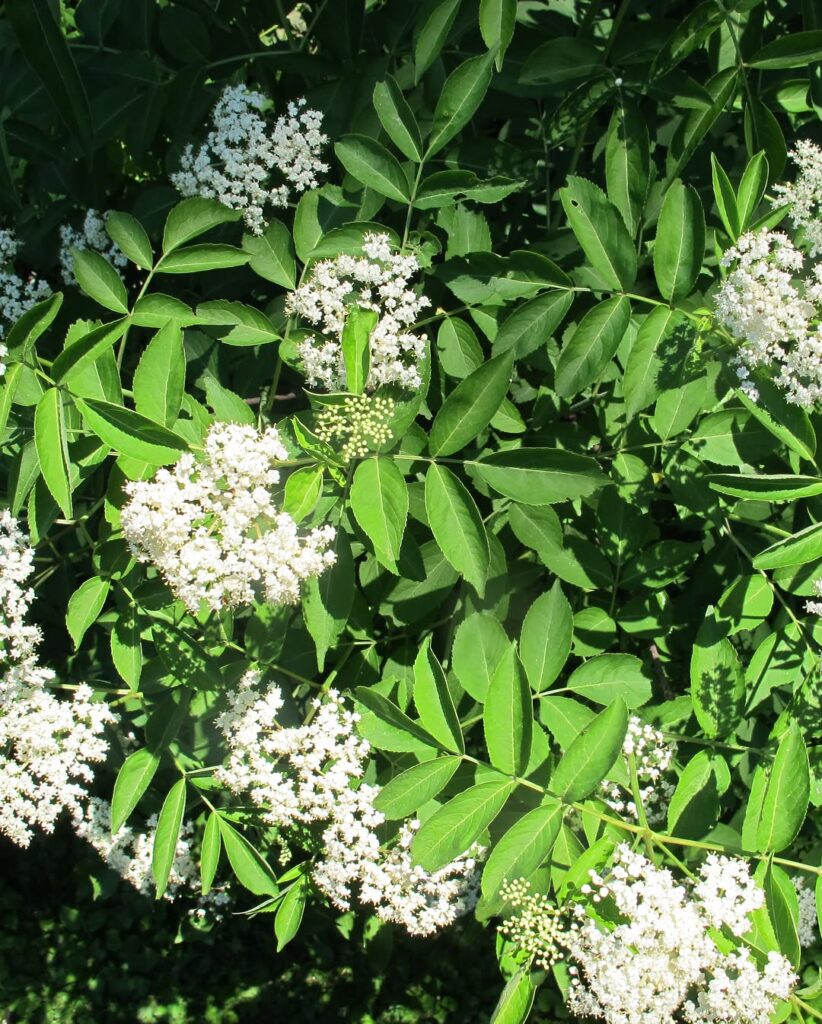
Elderberry (Sambucus canadensis) is an excellent low-maintenance native shrub perfectly suited for coastal Long Island gardens. This deciduous perennial grows up to 12 feet tall with an arching, multi-stemmed habit, featuring attractive pinnate leaves and producing clusters of white flowers followed by dark purple-black berries. Native to coastal regions throughout the Eastern United States, elderberry thrives in the moist, variable conditions typical of Long Island’s landscape.
This adaptable shrub excels in riparian areas, forest edges, and disturbed sites, making it ideal for naturalistic plantings and wildlife gardens. Its rapid growth rate has earned it recognition as an “instant hedge” plant, while its berries provide valuable food for birds and mammals. The flowers attract beneficial insects, contributing to the local ecosystem while requiring minimal care from gardeners. Elderberry also serves as an effective erosion control solution in moist coastal sites where soil stabilization is needed.
- Hardiness: USDA Zones 4a-8b, well-suited to coastal conditions
- Light: Full sun to partial shade (2-6 hours direct sunlight daily)
- Water: Prefers consistently moist soil, tolerates wet conditions and occasional flooding
- Soil: Highly adaptable to clay, sand, loam, or high organic matter soils; acidic to neutral pH (6.0-8.0)
- Fertilizer: Low to no fertilizer requirements; nitrogen-tolerant
- Pest/Disease Resistance: Generally pest and disease resistant with few serious issues
- Growth Rate: Medium to fast growth rate with rapid establishment
Selecting the Right Native Plants for Your Garden
When you’re choosing native plants for your Long Island garden, you’ll want to match each species to your specific growing conditions and landscape goals. Consider your soil type first—coastal sandy areas suit Sand Rose and Eastern Red Cedar, while wet spots thrive with Swamp Milkweed and Twig-rush.
Evaluate sunlight exposure carefully. Purple Coneflower needs full sun, but Lady Fern prefers shade. Your garden design should incorporate varied heights and textures—combine tall Pitch Pines with low-growing Sweetfern.
Smart planting techniques include grouping species with similar water needs together, creating natural-looking clusters rather than formal rows for authentic coastal appeal. Native plants also provide essential shelter and food sources for local wildlife, making your garden a habitat for birds, pollinators, and other beneficial species.
Frequently Asked Questions
When Is the Best Time to Plant Coastal Natives in Long Island?
You’ll find the best planting seasons for coastal natives are late summer through fall, when ideal soil conditions develop from perfect temperatures that encourage strong root establishment before winter dormancy begins.
How Much Do Coastal Native Plants Typically Cost Compared to Non-Natives?
You’ll find coastal pricing for natives ranges $9.99-$99.99 depending on size, while plant affordability improves long-term since they need less water, fertilizer, and pest control than non-natives, reducing ongoing maintenance costs considerably.
Where Can I Purchase Coastal Native Plants on Long Island?
Don’t put all your eggs in one basket—diversify your sourcing. You can purchase from specialized plant nurseries like Long Island Natives Nursery, Decker’s Nursery, or Hicks Nurseries, plus online retailers offer convenient ordering.
Do Coastal Native Plants Attract Deer or Other Wildlife Pests?
You’ll find most coastal natives offer excellent deer resistance due to tough textures and unpalatable compounds. While they provide wildlife benefits by attracting pollinators and birds, they don’t typically draw problematic pests like deer.
How Long Does It Take for Coastal Native Plants to Establish?
Your establishment timeframe depends on plant type and growth conditions. You’ll see herbaceous perennials establish within one season, shrubs need 1-2 years, while trees require 2-3 years for full establishment.
